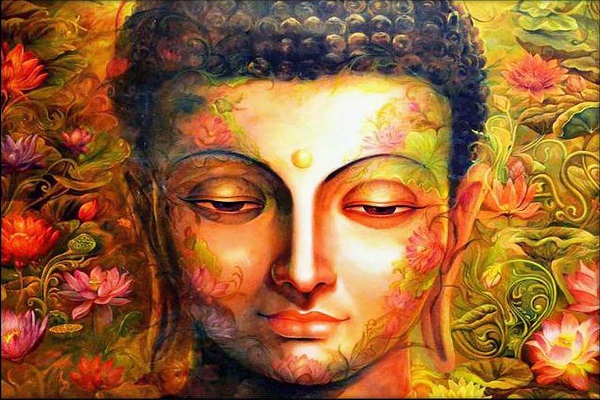
In the realm of art, few subjects can captivate the soul and uplift the spirit quite like Buddha paintings. These beautiful works of art have transcended time, carrying with them a profound sense of peace, serenity, and enlightenment. Their ability to create a tranquil atmosphere in any living space has made them increasingly popular in the world of home decor.
The trend of incorporating Buddha paintings into interior design has been on the rise, and it's not difficult to understand why. These stunning artworks not only add a touch of spirituality but also lend an air of sophistication and elegance to any room they grace. Whether it's a contemporary urban loft or a traditional countryside cottage, Buddha paintings have the power to transform the ambiance and create a serene sanctuary within the home.
Beyond their aesthetic appeal, Buddha paintings offer a multitude of benefits for those seeking to enhance their living space. The presence of these sacred art pieces can evoke a sense of mindfulness, promoting a calm and focused mindset in our fast-paced modern lives. Their tranquil imagery and serene expressions serve as gentle reminders to slow down, find inner peace, and reconnect with our spiritual selves.
To gain more details about how Buddha paintings can enrich your home decor and create a spiritually uplifting environment, read our blog. Immerse yourself in the beauty of these mesmerizing artworks and discover the transformative power they hold.
The Symbolism of Buddha Paintings
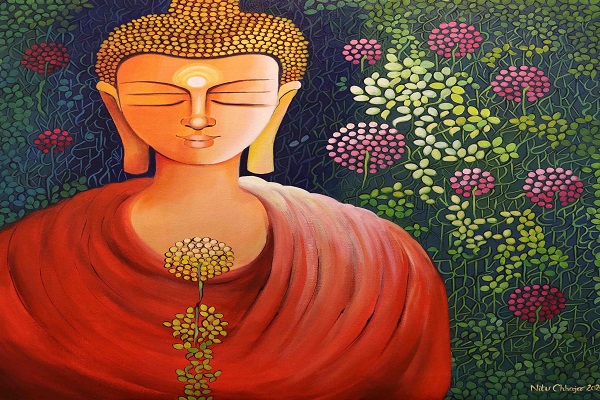
When gazing upon beautiful Buddha paintings, one can't help but be drawn into the intricate details and profound symbolism they embody. These exquisite artworks are rich in meaning, conveying spiritual messages that go beyond their visual allure. Let's delve into some of the symbolic elements often depicted in these paintings:
- Mudras (hand gestures): The positioning of Buddha's hands, known as mudras, holds significant meaning. each mudra represents a specific aspect of enlightenment or spiritual energy. For example, the "Abhaya Mudra" symbolizes fearlessness and protection, while the "Dhyana Mudra" signifies meditation and inner peace.
- Postures: Buddha paintings frequently showcase various postures, each with its own significance. The most common postures include the seated meditation pose, where the Buddha is shown deep in contemplation, and the teaching pose, where the Buddha imparts wisdom and compassion to his followers.
- Facial expressions: The serene expressions on Buddha's face capture the essence of tranquility and enlightenment. The gentle smile reflects inner bliss, while the closed eyes denote deep meditation and detachment from worldly desires.
- Halo and aura: A radiant halo or aura often surrounds the Buddha in paintings, symbolizing divine light and spiritual illumination. It represents the enlightened nature of the Buddha and serves as a reminder of the boundless wisdom and compassion that emanate from within.
The symbolic elements found in Buddha paintings hold profound spiritual meanings and can contribute to a positive and harmonious atmosphere in the home. By incorporating these beautiful paintings into your decor, you invite these symbols to permeate your living space and enrich your daily life.
The mudras depicted in Buddha paintings help to create a sacred ambiance. The specific hand gestures convey spiritual energies and intentions, infusing the surroundings with qualities such as peace, fearlessness, or compassion. They serve as visual reminders to cultivate these virtues in our own lives.
The various postures portrayed in Buddha paintings inspire us to seek inner peace and wisdom. The meditation pose encourages a calm and introspective mindset, inviting us to find solace amidst the chaos of everyday life. The teaching pose, on the other hand, symbolizes the importance of sharing knowledge and cultivating compassion towards others.
The serene facial expressions of Buddha in these paintings have a calming effect on our psyche. They remind us to find contentment and happiness within ourselves, regardless of external circumstances. The closed eyes signify the power of introspection and mindfulness, encouraging us to look inward and connect with our spiritual essence.
The halo or aura surrounding the Buddha represents the divine light and energy that permeates the universe. Its presence in the home creates a sense of transcendence, elevating the vibrations and promoting a serene and uplifting environment. It serves as a constant reminder of the inherent divinity within us all.
By understanding and appreciating the symbolic elements in Buddha paintings, we can harness their spiritual power to promote positive energy, mindfulness, and a deeper connection with our inner selves. embrace the beauty of these paintings and let them transform your home into a sacred sanctuary of peace and enlightenment.
Different Styles of Buddha Paintings:
Traditional Thangka Paintings
When it comes to beautiful Buddha paintings, one cannot ignore the allure of traditional Thangka art. Originating from the Himalayan regions, Thangka paintings are not merely artworks but sacred objects infused with spirituality. Let's delve into the unique characteristics and religious context of Thangka paintings:
- Discuss the origins and characteristics of Thangka art: Thangka paintings trace their roots back to ancient Tibet, Nepal, and Bhutan. These intricate artworks are typically painted on silk or cotton using mineral pigments and gold leaf. Thangkas are known for their meticulous details, vibrant colors, and precise proportions. They often depict deities, Buddhas, and spiritual figures, with each element carefully positioned to represent their symbolic significance.
- explain the religious and cultural context of Thangka paintings: Thangka art holds great religious and cultural importance in Tibetan Buddhism. These paintings serve as visual aids for meditation, conveying complex spiritual teachings and providing a focal point for devotion. They are regarded as windows to the divine, enabling practitioners to connect with enlightened beings and cultivate reverence. Thangka paintings are often displayed in monasteries, temples, and homes, where they inspire devotion and enhance the spiritual atmosphere.
Contemporary Interpretations
While traditional Thangka paintings have a timeless charm, contemporary interpretations of Buddha art have emerged, blending the old with the new. Artists have embraced innovative styles and techniques, infusing Buddha paintings with a fresh and modern aesthetic:
- explore modern artistic styles and techniques used in Buddha paintings: Contemporary artists employ diverse artistic styles to create stunning Buddha paintings. From impressionistic brushstrokes to bold abstract forms, these artworks showcase the artists' unique interpretations of the spiritual realm. Mixed media, digital art, and even sculpture are used to breathe new life into the depiction of Buddha, expanding the boundaries of traditional art forms.
- Highlight the fusion of traditional and contemporary elements in these artworks: Many artists blend traditional iconography with contemporary elements, resulting in captivating fusion artworks. These pieces often retain the sacred symbols and motifs of traditional Buddha paintings, while incorporating modern colors, textures, and compositions. The fusion of ancient wisdom with contemporary artistic expression creates a bridge between the past and the present, appealing to a wide range of art enthusiasts.
By exploring the traditional Thangka paintings and contemporary interpretations, we can witness the evolution and versatility of Buddha art. Whether you are captivated by the intricate details of Thangka or drawn to the boldness of contemporary styles, these beautiful paintings continue to inspire and connect us to the profound spirituality of the Buddha's teachings. Immerse yourself in the world of Buddha art and discover the timeless beauty that transcends cultures and generations.
Choosing the Right Buddha Painting for Your Home

When it comes to adorning your living space with beautiful Buddha paintings, finding the perfect piece can be an exciting and transformative journey. To ensure that the artwork harmonizes with your home's aesthetics and creates an ambiance of tranquility, consider the following factors:
- Consider the size and scale of the painting in relation to the available wall space: Before making a choice, evaluate the dimensions of the wall where you plan to display the Buddha painting. Larger artwork can make a bold statement and become a focal point in the room, while smaller paintings can be grouped together for a more subtle effect. Balancing the size and scale of the painting with the available wall space is essential for achieving visual harmony.
- explore different colour palettes and their effects on the overall ambiance: Buddha paintings come in a variety of colour palettes, each evoking a distinct mood and energy. Cool tones like blues and greens create a serene and calming atmosphere, while warmer hues like oranges and yellows add vibrancy and energy. Consider the existing colour scheme of your room and choose a painting that complements or accentuates it. The right colour palette can enhance the overall ambiance and evoke the desired emotions.
- Discuss the significance of selecting a Buddha painting that resonates with personal beliefs and spiritual practices: Buddha paintings hold deep spiritual significance. It is essential to select a painting that resonates with your personal beliefs and spiritual practices. Whether you connect with the serenity of a meditating Buddha or the compassion of a teaching Buddha, choosing an artwork that aligns with your spiritual journey will enhance the meaningfulness of the piece and its impact on your daily life.
- Offer tips on matching the painting with existing home decor and interior design styles: To create a harmonious environment, consider how the Buddha painting will complement your existing home decor and interior design style. If your home features a minimalist aesthetic, opt for a painting with clean lines and simplicity. In contrast, if your decor leans towards eclectic or bohemian styles, embrace paintings with intricate details and vibrant colours. By considering the overall theme and style of your home, you can ensure that the Buddha painting seamlessly integrates into your existing design scheme.
Remember, the right Buddha painting for your home is not just a matter of aesthetics but also a reflection of your spiritual journey and personal taste. Take the time to explore various options, envision how the artwork will interact with your space, and choose a piece that speaks to your heart. Let the presence of a carefully chosen Buddha painting bring serenity, inspiration, and a sense of connection to your home.
Placement and Display
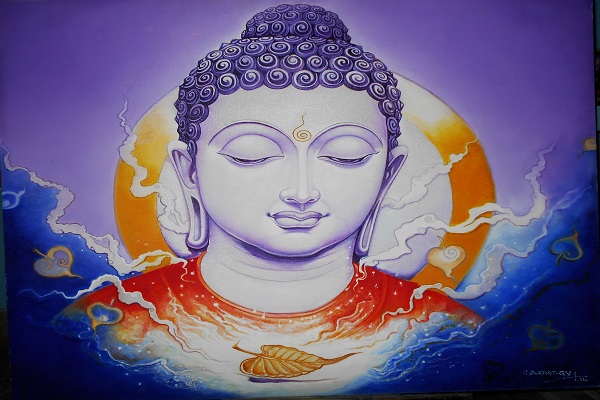
Once you have chosen beautiful Buddha paintings to grace your home, the next step is to consider their optimal placement and display. The way you position and present these artworks can greatly enhance their visual impact and create a harmonious atmosphere. Consider the following pointers:
Discuss the ideal locations for displaying Buddha paintings in the home: Buddha paintings can be showcased in various areas of your home to infuse each space with a sense of serenity and spirituality. Some ideal locations include the living room, where they can become a focal point and spark conversations. The bedroom, with its intimate setting, is perfect for creating a tranquil retreat. You can also consider displaying them in meditation spaces, hallways, or entrance foyers to set a peaceful tone from the moment you enter.
Provide tips on arranging multiple paintings or creating a focal point with a single artwork: If you have multiple Buddha paintings, arranging them thoughtfully can create a visually pleasing display. Consider grouping them together on a single wall or creating a gallery-style arrangement. Maintain proper spacing between the paintings to allow each piece to stand out individually. Alternatively, if you have a single stunning artwork, you can make it a focal point by placing it in a prominent location, such as above a fireplace or on a feature wall.
explain the importance of proper lighting and framing to enhance the visual impact: Lighting and framing play a crucial role in showcasing the beauty of Buddha paintings. Proper lighting can highlight the colours and details of the artwork. Natural light can create a soft and serene ambiance, while carefully positioned artificial lighting can accentuate specific elements. Additionally, choose frames that complement the painting and your home's aesthetic. Opt for frames that are simple and elegant, allowing the artwork to take center stage while providing protection and preservation.
By considering the ideal locations, arrangement techniques, and thoughtful lighting and framing, you can ensure that your Buddha paintings receive the attention they deserve. Their presence will not only enhance the visual appeal of your home but also create an atmosphere of tranquility and spiritual contemplation. Let these sacred artworks serve as a visual reminder of the beauty and serenity that can be found within and around us.
Creating a Serene Atmosphere with Buddha Paintings
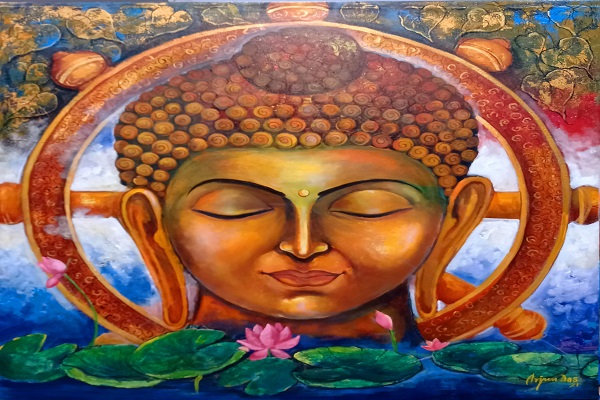
Beautiful Buddha paintings have the extraordinary power to transform our living spaces into tranquil sanctuaries, radiating serenity and promoting inner peace. Let's delve into how these artworks can create a serene atmosphere and explore ways to complement them with other elements of Zen or mindfulness in home decor:
explore the calming and meditative effects of Buddha paintings: Buddha paintings have a profound impact on our emotional and mental well-being. Their serene imagery, coupled with the spiritual symbolism they embody, can evoke a sense of calmness and tranquility. When we gaze upon these artworks, we are reminded to slow down, let go of worldly concerns, and embrace a more mindful and present state of being. The presence of Buddha paintings in our living spaces can serve as a visual anchor for moments of meditation and reflection, allowing us to find solace amidst the chaos of daily life.
Discuss how these artworks can contribute to a peaceful and harmonious living space: The presence of Buddha paintings can create a serene and harmonious ambiance in our homes. Their gentle imagery and spiritual symbolism invite a sense of balance and inner peace. Placing Buddha paintings in key areas, such as the living room or bedroom, allows their energy to permeate the space and influence the overall atmosphere. The calmness exuded by these artworks can help reduce stress levels, promote relaxation, and foster a greater sense of well-being for both residents and guests.
Offer suggestions for incorporating other elements of Zen or mindfulness into the home decor to complement the Buddha paintings: To complement the serenity of Buddha paintings, consider incorporating other elements of Zen or mindfulness into your home decor. Here are a few suggestions:
- Natural elements: embrace nature-inspired elements such as indoor plants, bamboo accents, or a small water fountain to create a soothing and harmonious environment.
- Minimalist Design: Adopt a minimalist approach to interior design, focusing on simplicity and decluttering. Clean lines, uncluttered spaces, and a neutral colour palette can create a sense of calm and serenity.
- Meditation Space: Create a dedicated meditation or mindfulness corner in your home, complete with cushions, a soft rug, and perhaps a small altar with Buddha statues or candles. This space can serve as a retreat for quiet reflection and introspection.
- Soft Lighting: Utilize soft, warm lighting options like Himalayan salt lamps or dimmable fixtures to create a calming and cozy atmosphere.
- Mindful Art: Complement the Buddha paintings with other mindful artworks, such as nature-inspired landscapes or abstract pieces that promote a sense of tranquility and introspection.
By incorporating these suggestions alongside your beautiful Buddha paintings, you can create a serene and mindful living space that nurtures your well-being and promotes a deep sense of peace. Allow the synergy of these elements to inspire and uplift your daily life, inviting a greater connection with your inner self and the world around you.
Caring for Buddha Paintings
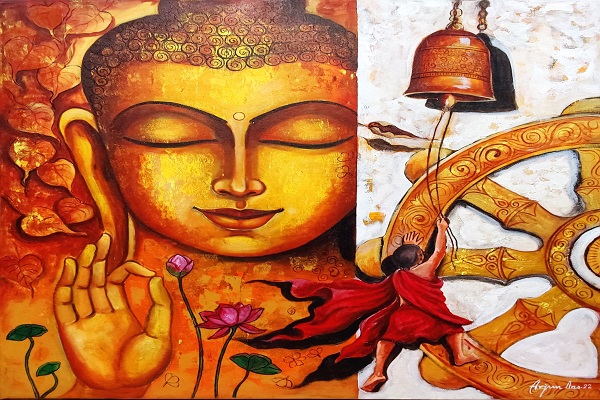
To ensure that your beautiful Buddha paintings retain their longevity and vibrancy, proper care and maintenance are crucial. By following these tips, you can preserve the artistic integrity of these precious artworks:
How to preserve the longevity and vibrancy of Buddha paintings:
- Display Considerations: Choose a suitable location for displaying your Buddha paintings. Avoid placing them in areas that are exposed to direct sunlight, as prolonged exposure can fade the colours over time. Additionally, keep them away from areas with excessive moisture or fluctuating temperatures, as these conditions can damage the painting.
- Handling with Care: When handling Buddha paintings, make sure your hands are clean and dry to avoid transferring dirt, oil, or moisture onto the surface. Use cotton gloves if necessary, as fingerprints can leave unwanted marks over time. Be mindful of the painting's delicate nature and avoid placing any pressure on the surface.
Proper cleaning and maintenance techniques:
- Dusting: Regularly dust your Buddha paintings using a soft, clean, and dry brush or a feather duster. Gently brush the surface in one direction to remove any loose particles. Avoid using any cleaning agents or liquids directly on the painting, as they can cause irreparable damage.
- Professional Conservation: If you notice any signs of damage or deterioration, such as flaking paint or discoloration, it is advisable to consult a professional art conservator. They can provide expert guidance on restoration and conservation techniques to preserve the artwork's integrity.
Importance of avoiding direct sunlight and excessive moisture
- Sunlight Protection: Direct sunlight can be detrimental to the longevity of Buddha paintings. UV rays can fade the colours and weaken the pigments. To protect your artwork, position it away from windows or use UV-protective glass or acrylic frames that filter out harmful rays.
- Moisture Control: excessive moisture can lead to mould growth, warping, or paint damage. Avoid hanging Buddha paintings in areas with high humidity, such as bathrooms or kitchens. Use dehumidifiers or moisture-absorbing materials if necessary to maintain a stable environment.
By implementing these care practices, you can safeguard the beauty and integrity of your Buddha paintings for years to come. Remember, these artworks hold deep spiritual and aesthetic significance, and proper care will ensure that they continue to radiate their serene charm and inspire contemplation for generations to come.
Conclusion
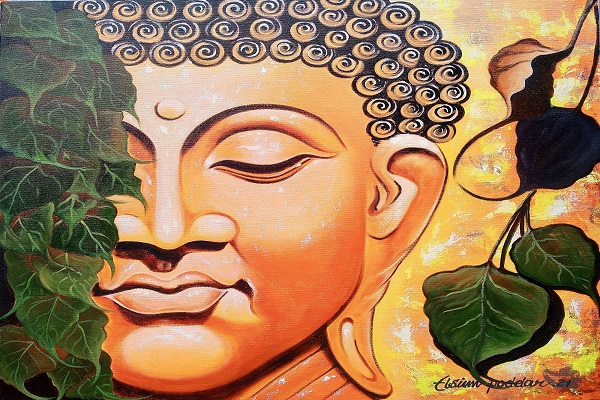
In the realm of home decor, Buddha paintings stand as exquisite examples of spiritual art, capable of enhancing the ambiance of any living space. These beautiful paintings not only add aesthetic appeal but also evoke a sense of serenity and inner peace. As we conclude this exploration into the world of Buddha paintings, we encourage you to delve deeper into their spiritual and aesthetic aspects.
At IndianArtIdeas, you can embark on a captivating journey of discovering a wide range of Buddha paintings, each with its unique symbolism and artistic expression. Immerse yourself in the profound meanings conveyed through mudras, postures, facial expressions, and halos depicted in these artworks. Allow their calming and meditative effects to resonate within your home, creating a tranquil haven where the spirit can find solace.
Remember, the selection of the right Buddha painting is a personal journey that goes beyond mere decoration. It is an opportunity to connect with your inner beliefs, values, and spiritual practices. Choose a painting that speaks to your heart and aligns with your individual journey.
As you integrate Buddha paintings into your home, consider the placement, lighting, and other elements of Zen or mindfulness to create a serene atmosphere. Let these artworks become focal points of reflection and contemplation, guiding you toward a more peaceful and harmonious existence.
In the care of your Buddha paintings, remember to handle them with the utmost care, avoid direct sunlight and excessive moisture, and seek professional advice when needed. By preserving their longevity and vibrancy, you ensure that these artistic treasures continue to inspire and uplift your living space for years to come.
Art possesses a transformative power, and Buddha paintings are no exception. Through their serene presence, they invite us to explore the depths of our spirituality and to create a sacred and tranquil living environment. embrace the transformative power of art and let the beauty of Buddha paintings infuse your home with a sense of peace, serenity, and inner harmony.
To embark on your journey of discovering exquisite Buddha paintings and other captivating artworks, visit IndianArtIdeas and explore the vast collection that awaits you. Transform your home into a sanctuary of beauty and spirituality, where the transformative power of art can be felt in every corner.





















